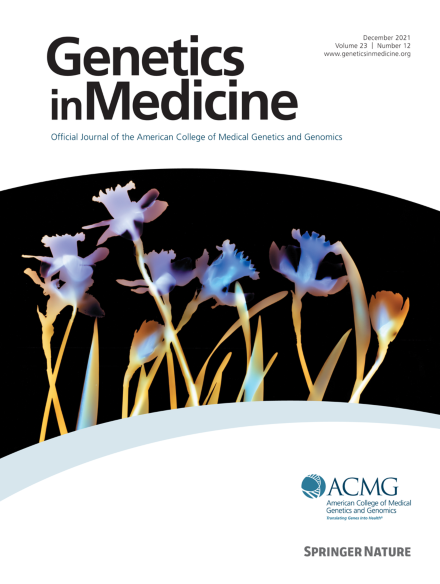利用临床直觉提高表型驱动优先排序的准确性。
IF 6.6
1区 医学
Q1 GENETICS & HEREDITY
引用次数: 0
摘要
目的:临床直觉通常被纳入鉴别诊断中,作为根据特定诊所就诊的患者群体或最初表现的体征和症状对候选诊断可能性的评估。支持对疑似罕见遗传病患者进行诊断测序的算法尚未纳入直觉,而是假定每种孟德尔疾病的检测前概率相同:LIRICAL算法计算人类表型本体(HPO)术语所代表的临床表现的似然比,对候选诊断进行排序。LIRICAL 算法的初始版本在计算检测后概率时假定每种疾病的检测前概率相同(检测为诊断性外显子组或基因组测序)。我们引入了临床直觉似然比(Clinical Intuition for Likelihood Ratios,ClintLR),它是 LIRICAL 算法的扩展,可提高被认为更有可能的相关疾病组的检测前概率:结果:在使用 ClintLR 的模拟实验中,正确诊断的平均等级在一系列调整因素的作用下有显著的统计学改善:结论:ClintLR 成功地编码了临床直觉,提高了诊断测序中罕见病的排序。ClintLR 可在 https://github.com/TheJacksonLaboratory/ClintLR 免费获取。本文章由计算机程序翻译,如有差异,请以英文原文为准。
Leveraging clinical intuition to improve accuracy of phenotype-driven prioritization
Purpose
Clinical intuition is commonly incorporated into the differential diagnosis as an assessment of the likelihood of candidate diagnoses based either on the patient population being seen in a specific clinic or on the signs and symptoms of the initial presentation. Algorithms to support diagnostic sequencing in individuals with a suspected rare genetic disease do not yet incorporate intuition and instead assume that each Mendelian disease has an equal pretest probability.
Methods
The LIkelihood Ratio Interpretation of Clinical AbnormaLities (LIRICAL) algorithm calculates the likelihood ratio of clinical manifestations represented by Human Phenotype Ontology terms to rank candidate diagnoses. The initial version of LIRICAL assumed an equal pretest probability for each disease in its calculation of the posttest probability (where the test is diagnostic exome or genome sequencing). We introduce Clinical Intuition for Likelihood Ratios (ClintLR), an extension of the LIRICAL algorithm that boosts the pretest probability of groups of related diseases deemed to be more likely.
Results
The average rank of the correct diagnosis in simulations using ClintLR showed a statistically significant improvement over a range of adjustment factors.
Conclusion
ClintLR successfully encodes clinical intuition to improve ranking of rare diseases in diagnostic sequencing. ClintLR is freely available at https://github.com/TheJacksonLaboratory/ClintLR.
求助全文
通过发布文献求助,成功后即可免费获取论文全文。
去求助
来源期刊

Genetics in Medicine
医学-遗传学
CiteScore
15.20
自引率
6.80%
发文量
857
审稿时长
1.3 weeks
期刊介绍:
Genetics in Medicine (GIM) is the official journal of the American College of Medical Genetics and Genomics. The journal''s mission is to enhance the knowledge, understanding, and practice of medical genetics and genomics through publications in clinical and laboratory genetics and genomics, including ethical, legal, and social issues as well as public health.
GIM encourages research that combats racism, includes diverse populations and is written by authors from diverse and underrepresented backgrounds.
 求助内容:
求助内容: 应助结果提醒方式:
应助结果提醒方式:


